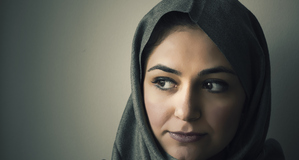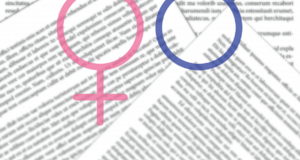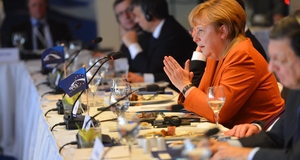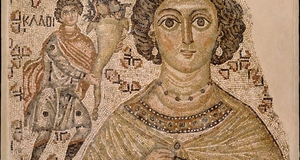Awareness of Emirati Women's Economic Roles Before the Oil Boom: Changing Perceptions of Gender Roles?
By
2016, Vol. 8 No. 10 | pg. 2/2 | « Implications and DiscussionFemale Perceptions of Female EmploymentThe fact that women associate Emirati women’s roles in the pre-oil era solely with the domestic sphere has several implications. The first is in regards to how an in-depth understanding of women’s economic roles before the oil may possibly affect their perceptions of working women today, especially of women who interact heavily with the public and/or are in leadership positions. For example, would women today have more favorable perceptions of female employment if they associated it with deeply rooted cultures and traditions? As an Emirati female, I have found that women’s attitudes towards female leadership is ambivalent. In another research I conducted at Zayed University (currently under review), I found that almost all female students wanted to be leaders, but did not have particularly positive perceptions of female leaders. Negative perceptions of female leaders by other females has been well documented (Becker 2010; Becker and Wagner 2009; Kilianski and Rudman 1998), including in Western societies which are commonly described as less patriarchal than those of the East. My own findings at the university showed similar results. Going back to SDT and legitimizing myths (Sidanius and Pratto 1999), those at the bottom of the hierarchy (in this case, women) endorse negative views of themselves (that they are only suited to the domestic sphere, for example). In the case of the UAE, it is possible that Emirati females who hold negative perceptions of female leadership are influenced by the idea that the Emirati woman’s primary place is at home, rather than in the workplace, which they may believe she is not suited for.Indeed, it is possible that the negative perceptions of Emirati female leadership are partly due to the idea that those working outside the house, especially in environments where they are heavily exposed to men, are not in a very “respectable” position, especially if they have the choice of being at home. Knowing that traditions are a very important aspect in Emirati society, it is therefore possible that many may associate more positive connotations to a “traditional” way of life in comparison to a “modern” lifestyle. That is, if women in the UAE “traditionally” only worked at home, this implicitly becomes the “authentic” way for an Emirati woman to act, the way that “good” women lived their lives. The low employment rates in the UAE are indicative of that (Kemp and Zhao 2016, 989). Indeed, even if the government currently promotes female employment and leadership, society’s ambivalent attitudes towards this issue showcases the way society is torn between a “traditional” or “modern” lifestyle. Thus, if social reproductions changed to commonly show a “traditional” woman to have worked outside the house rather than only in the domestic sphere, it is possible that perceptions of working women, and even women in leadership, may be different. Double BurdenWhile we expect that positive developments may occur if there is more awareness in terms of females’ economic roles before the oil, such an awareness may also have negative repercussions. Showcasing the many roles that women played before the oil may place a double burden on women (which is already the case today). Indeed, working women, including women in leadership, are expected to both be full-time workers while being full-time wives and mothers. The idea of sharing household and caregiving duties between the wife and husband is very uncommon in the Gulf region, and the husband is still expected to be the “breadwinner,” even if the wife contributes significantly to the household (Metcalfe 2008). While the husband is only expected to fulfill his full-time job, the woman is expected to fulfill her full-time mother “duties” if she is to work. While the father is rarely ever considered negligent of he does not share household responsibilities, the working woman is usually considered so if she does not. Meanwhile, the Emirati woman in the pre-oil era did indeed have to fulfill multiple responsibilities, as there was no other option at a time of lesser financial means. Women had to both work to sustain their family’s livelihood as well as to take care of the household. If this scenario becomes representative of “traditional” Emirati life, it is possible that society may expect women to perform the same roles as she traditionally did. Indeed, there is already a common perception in society that women today are too “spoiled” (this perception also applies to men). However, while men are only expected to contribute financially to the family, the working woman is still also expected to be a full-time wife and mother. The “ideal” working woman is one who does both jobs, rather than one who shares responsibilities with her husband. Since the belief that a working woman should also be a full-time mother already exist, increased awareness of women’s economic roles before the oil might imply to some that this is the only correct way for a working woman to live. The implication is: “if women before did it, why can’t women now do it?” It is important to note that many working women today either have nannies or leave their children in their own mother’s care, which allows them to have more time to focus on work. While women do get help from outside, they are still expected to take up the rest of the burden at home (again, without the expectation that the husband shares in those duties). ConclusionThe survey results have shown that at least half of the female respondents are aware of Emirati women’s economic roles pre-oil. However, my own experience in teaching Emirati Studies, and a quasi-experiment I conducted, shows contrary findings. Indeed, most interactions have shown that the “traditional” Emirati woman is associated with one whose sole work is in the domestic sphere. Similarly, formal reproductions often promote this idea as well. Therefore, while Emiratis may have some knowledge about women’s economic life in the pre-oil Emirates, they still primarily imagine these women’s roles being restricted to the domestic sphere. Modernization and oil wealth, which significantly lessened the need for women to work, helped in creating this perception over the decades as most women stayed at home. As it is only recently that women started joining the workforce, women’s employment came to be seen as a recent and modern development, rather than a continuation to a long trend of women’s economic contributions after a period of stagnation. What then, might change if Emiratis had not only more awareness of women’s economic roles pre-oil, but if this image of the “traditional” working woman is commonly promoted in social reproductions in place of the “traditional” domestic woman? The implications are twofold: it is possible that such awareness may promote more positive perceptions of female employment and leadership as it showcases that a working woman has always been part of Emirati traditions. However, it may also place a double burden on women, as they may be expected to become both full-time workers as well as full-time mothers in the same manner that “traditional” mothers were, rather than promoting the idea of shared responsibilities between a working wife and husband. It is not clear if this will indeed be the case, and further research is required to answer these questions. ReferencesAl Awad, M. (2015). Altamkyn al’yqtysady wa tashghyl ’almar’a fy dawlat Al’ymarat Alʿarabya Almutahyda (Economic empowerment and female employment in the United Arab Emirates). Institute of Social and Economic Research – Zayed University. Al-Sayegh, F. (2001). Women and economic changes in the Arab Gulf: The case of the United Arab Emirates. Digest of Middle East Studies, 10(2), 17-39. DOI: 10.1111/j.1949-3606.2001.tb00419. Becker, J. C. (2010). Why do women endorse hostile and benevolent sexism? The role of salient female subtypes and internalization of sexist contents. Sex Roles: A Journal of Research, 62(7), 453-467. doi: 0.1007/s11199-009-9707-4 Becker, J. C., & Wagner U. (2009) Doing gender differently—The interplay of strength and content of gender identity in predicting women’s endorsement of sexist beliefs. European Journal of Social Psychology, 39(4), 487–508. DOI:10.1002/ejsp.551 Bristol-Rhys, J. (2008). The dilemma of gender-separated higher education in the United Arab Emirates, in Davidson, C. & Mackenzie Smith, P. (eds), Higher education in the Gulf States: Shaping economies, politics and culture, Saqi, London. El Saadi, H. (2012). Women and the economy: Pre-oil Gulf States. In Gulf Women, edited by Amira El-Azhary Sonbol, 147-166. Doha, Qatar: Bloomsbury Qatar Foundation Publishing Garcia-Retamero, R. & López-Zafra, E. (2006). Prejudice against women in male-congenial environments: Perceptions of gender role congruity in leadership. Sex Roles, 55, 51-61. DOI 10.1007/s11199-006-9068-1 Glick, P. & Fiske, S. (2001). An ambivalent alliance: Hostile and benevolent sexism as complementary justifications for gender inequality. American Psychologist, 56: 109–118. Kemp, Linzi J. (2013). Progress in female education and employment in the United Arab Emirates towards Millennium Development Goal (3) – gender equality,” Foresight: The Journal of Future Studies, Strategic Thinking and Policy, 15(4), pp. 264-277. Kemp, Lizi J., & Zhao F. (2016). Influences of cultural orientations on Emirati women’s careers, Personnel Review, 45(5) pp. 988 – 1009 http://dx.doi.org/10.1108/PR-08-2014-0187 Kilianski, S., & Rudman L. (1998). Wanting it both ways: Do women approve of benevolent sexism? Sex Roles, 39(5), 333–352. DOI 10.1023/A:1018814924402 Khoori, A., & Dajani H. (2015, November 18). Dr Amal Al Qubaisi becomes region’s first female leader of a national assembly. The National. Retrieved from http://www.thenational.ae/uae/dr-amal-al-qubaisi-becomes-regions-first-female-leader-of-a-national-assembly Khoori, A. (2015, October 4). Emirati women disappointed in lack of female representation in FNC. The National, Retrieved from http://www.thenational.ae/uae/government/20151004/emirati-women-disappointed-in-lack-of-female-representation-in-fnc Lootah, K., Huwaidy, M., Al-Nouman, R., & Abdulwahid, S., (1993). ‘zuf almuwaṭinat ‘an almusharaka altatawu’ya fy aljam‘yaat alnysa’ya bydawlat Al’ymarat Al‘arabya Almutahida (Reluctance of Emirati national women in participating in Women’s Associations in the UAE). Ajman, UAE: Jam‘iyat ’um almu’mynyyn ’alnysaa’ya: Al’ymarat Al’arabya Almutaḥyda: ‘ajman (Um Al Mu’mynyyn Women’s Society: UAE, Ajman) Maitra, J. (2007). Zayed: From challenges to union. Abu Dhabi: The National Archives, p. 50. Metcalfe, B. D. (2008). Women, management and globalization in the Middle East. Journal of Business Ethics. 83: 85-100. DOI 10.1007/s10551-007-9654-3 Ministry of Education, UAE (2015). National Education (for Grades 9-12) [Altarbiya alwaṭaniya] Minsitry of Higher Education, UAE (2015). Emirati Studies [Dirasat Emaratiya] Soffan, L. U. (1980). The women of the United Arab Emirates. USA: Harper & Row Publishers, Inc., Barnes & Noble Import Division Sidanius, J. & Pratto F. (1999). Social dominance: An intergroup theory of social hierarchy and oppression. Cambridge, New York: Cambridge University Press The National Staff Writer (2016 February 10). Sheikh Mohammed bin Rashid announces new UAE Cabinet. The National. Retrieved from http://www.thenational.ae/uae/sheikh-mohammed-bin-rashid-announces-new-uae-cabinet Endnotes1.) Textbooks from different parts of the world have been found to promote gender stereotypes. For more on information see Táboas-Pais, María Inés and Ana Rey-Cao. 2012. “Gender Differences in Physical Education Textbooks in Spain: A Content Analysis of Photographs.” Sex Roles 67:389-402; Lee, Jackie and Peter Collins. 2008. “Gender Voices in Hong Kong English Textbooks- Some Past and Current Voices” Sex Roles 59:127-137; Low, Jason and Peter Sherrard. 1999. “Portrayal of Women in Sexuality and Marriage and Family Textbooks: A Content Analysis of Photographs from the 1970s to the 1990s.” Sex Roles 40:309-318. Suggested Reading from Inquiries Journal
Inquiries Journal provides undergraduate and graduate students around the world a platform for the wide dissemination of academic work over a range of core disciplines. Representing the work of students from hundreds of institutions around the globe, Inquiries Journal's large database of academic articles is completely free. Learn more | Blog | Submit Latest in Women's & Gender Studies |


















